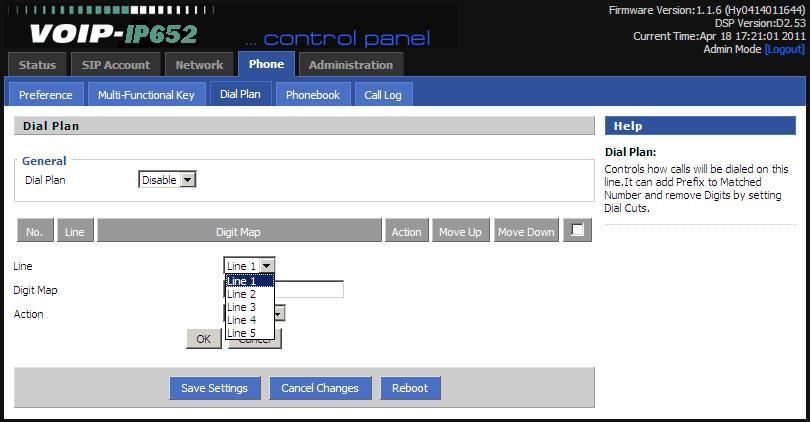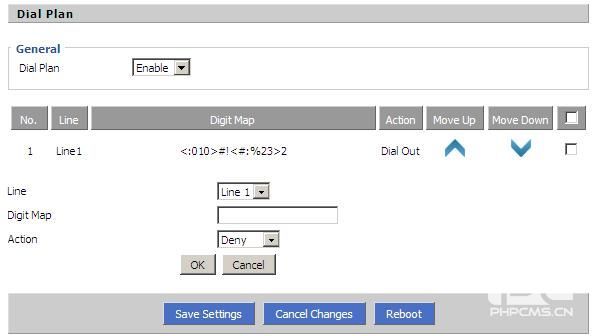-
Capacitación
Dial Plan Overview
Tiempo de liberación:Jan 16, 2018
Introduction
This overview briefly introduced the dial plan of Flying Voice products. To get more information about dial plan,please refer to the user manual of the product which you get.
The dial plan specifies how to interpret digit sequences dialed by the user, and how to convert those sequences into an outbound dial string. The Flying Voice products allow each line to be configured with a distinct dial plan.
Webpage
Assuming that you own an Flying Voice product, you should access to the 'Admin mode' and open " Phone→Dial
Plan" webpage to configuration dial plan.
Below picture 1 and picture 2 are the Dial Plan webpage of IP652, the webpage of other Flying Voice products is same as the IP652.

Picture 1 IP652 Phone/Dial Plan webpage

Picture 2 Dial Plan
Configuration Page
The dial plan functionality is regulated by the following configurable parameters:
* Dial Plan Enable: to enable or disable dial plan
* No.: the series number of dial plan.
* Line: the line you want to configuration, you can create dial plans to different lines; choose the line which you'd like to modify the dial plan from Line parameter.
* Dial Plan Enable: to enable or disable dial plan
* No.: the series number of dial plan.
* Line: the line you want to configuration, you can create dial plans to different lines; choose the line which you'd like to modify the dial plan from Line parameter.
* Digit Map: the digit map string of dial plan
* Action: choose the action from deny or dial out
* Move Up/Down: replace the highlighted dial plan, press the up button to move it up, press the down button to move it down.
* The dial plans contain a series of digit sequences, when a user dials a series of digits; each sequence in the dial plan is tested as a possible match from the first one to the last one. The matching sequences form a set of candidate digit sequences. As more digits are entered by the user, the set of candidates diminishes until only one or none are valid. Any one of a set of terminating events triggers the Flying Voice products to accept the user-dialed sequence and continue the next step (action: deny the call or dial out the call), or else transmit the input phone number as dialed
* Action: choose the action from deny or dial out
* Move Up/Down: replace the highlighted dial plan, press the up button to move it up, press the down button to move it down.
* The dial plans contain a series of digit sequences, when a user dials a series of digits; each sequence in the dial plan is tested as a possible match from the first one to the last one. The matching sequences form a set of candidate digit sequences. As more digits are entered by the user, the set of candidates diminishes until only one or none are valid. Any one of a set of terminating events triggers the Flying Voice products to accept the user-dialed sequence and continue the next step (action: deny the call or dial out the call), or else transmit the input phone number as dialed
The terminating events are:
* No candidate sequences remain: transmit the input phone number as dialed
* Only one candidate sequence remains, and it has been matched completely: the number is accepted and transmitted the number if the value of the action parameter is dial out, or else the number will be rejected.
* More than one candidates sequence remains, a timeout occurs: the digit sequence is accepted and transmitted as dialed if incomplete, or transformed as per the dial plan if complete.
* An explicit ‘send’ (user presses the ‘#’ key): the digit sequence is accepted and transmitted as dialed if incomplete, or transformed as per the dial plan if complete.
* No candidate sequences remain: transmit the input phone number as dialed
* Only one candidate sequence remains, and it has been matched completely: the number is accepted and transmitted the number if the value of the action parameter is dial out, or else the number will be rejected.
* More than one candidates sequence remains, a timeout occurs: the digit sequence is accepted and transmitted as dialed if incomplete, or transformed as per the dial plan if complete.
* An explicit ‘send’ (user presses the ‘#’ key): the digit sequence is accepted and transmitted as dialed if incomplete, or transformed as per the dial plan if complete.
The timeout duration depends on the matching state.
If a candidate sequence is complete, the Timer Overrides T applies.
If no candidate sequences are as yet complete (as dialed), the Dial Time Out applies. You can change the value of dial time out in Phone/Preference webpage, miscellaneous column like below:
If a candidate sequence is complete, the Timer Overrides T applies.
If no candidate sequences are as yet complete (as dialed), the Dial Time Out applies. You can change the value of dial time out in Phone/Preference webpage, miscellaneous column like below:

Picture 3 Miscellaneous Column in Phone/Preference
webpage
Digit Map Syntax
Elements can be one of the following:
* Individual keys ‘0’, ‘1’, ‘2’ . . . ‘9’, ‘*’, ‘#’.
* The lower English letter ‘x’ matches any one numeric digit (‘0’…….‘9’)
* A subset of keys within brackets (allows ranges): ‘[‘ set ‘]’ (e.g. [389] means ‘3’ or ‘8’ or ‘9’)
* Numeric ranges are allowed within the brackets: digit ‘-‘ digit (e.g. [2-9] means ‘2’ or ‘3’ or… or ‘9’)
* Ranges can be combined with other keys: e.g. [235-8*] means ‘2’ or ‘3’ or ‘5’ or ‘6’ or ‘7’ or ‘8’ or ‘*’.
For example, “01.” matches “0”, “01”, “011”, “0111” … etc.
Subsequence Substitution
A subsequence of keys (possibly empty) can be automatically replaced with a different subsequence using
an angle bracket notation: ‘<’ dialed-subsequence ‘:’ transmitted-subsequence ‘>’.
So, for example, “<8:1650>xxxxxxx” would match “85551212” and transmit “16505551212”.
Inter-sequence Tones
An “outside line” dial tone can be generated within a sequence by appending a ‘,’ character between digits. Thus, the sequence “9, 1xxxxxxxxxx” sounds an “outside line” dial tone after the user presses ‘9’, until the ‘1’ is pressed. For an office environment, the following plan requires a user to dial 8 as a prefix for local calls and 9 as a prefix for long distance. In either case, an “outside line” tone is played after the initial 8 or 9, and neither prefix is transmitted when initiating the call.
<9,:> 1 xxx xxxxxxx
<8,:111> xxxxxxx
Timer Overrides T
The syntax for timer override is: ‘T ‘delay-value ‘’, the specified delay-value is measured in seconds.For example, you configuration a dial plan digit sequence ‘01133xxxxxxxxxxT3’; so when this sequence matched completely, it overrides the Dial Time Out and causing an immediate call after 3 seconds.The timer overrides T applies only the sequence is matched completely and in default the delay-value of timer overrides T is 0.
* Individual keys ‘0’, ‘1’, ‘2’ . . . ‘9’, ‘*’, ‘#’.
* The lower English letter ‘x’ matches any one numeric digit (‘0’…….‘9’)
* A subset of keys within brackets (allows ranges): ‘[‘ set ‘]’ (e.g. [389] means ‘3’ or ‘8’ or ‘9’)
* Numeric ranges are allowed within the brackets: digit ‘-‘ digit (e.g. [2-9] means ‘2’ or ‘3’ or… or ‘9’)
* Ranges can be combined with other keys: e.g. [235-8*] means ‘2’ or ‘3’ or ‘5’ or ‘6’ or ‘7’ or ‘8’ or ‘*’.
Element repetition
Any element can be repeated zero or more times by appending a period (‘.’ character) to the element.
For example, “01.” matches “0”, “01”, “011”, “0111” … etc.
Subsequence Substitution
A subsequence of keys (possibly empty) can be automatically replaced with a different subsequence using
an angle bracket notation: ‘<’ dialed-subsequence ‘:’ transmitted-subsequence ‘>’.
So, for example, “<8:1650>xxxxxxx” would match “85551212” and transmit “16505551212”.
Inter-sequence Tones
An “outside line” dial tone can be generated within a sequence by appending a ‘,’ character between digits. Thus, the sequence “9, 1xxxxxxxxxx” sounds an “outside line” dial tone after the user presses ‘9’, until the ‘1’ is pressed. For an office environment, the following plan requires a user to dial 8 as a prefix for local calls and 9 as a prefix for long distance. In either case, an “outside line” tone is played after the initial 8 or 9, and neither prefix is transmitted when initiating the call.
<9,:> 1 xxx xxxxxxx
<8,:111> xxxxxxx
Timer Overrides T
The syntax for timer override is: ‘T ‘delay-value ‘’, the specified delay-value is measured in seconds.For example, you configuration a dial plan digit sequence ‘01133xxxxxxxxxxT3’; so when this sequence matched completely, it overrides the Dial Time Out and causing an immediate call after 3 seconds.The timer overrides T applies only the sequence is matched completely and in default the delay-value of timer overrides T is 0.










 volver a la lista
volver a la lista




